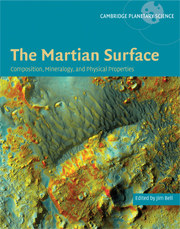Book contents
- Frontmatter
- Contents
- List of contributors
- Foreword
- Acknowledgments
- Part I Introduction and historical perspective
- Part II Elemental Composition: Orbital and in situ Surface Measurements
- Part III Mineralogy and Remote Sensing of Rocks, Soil, Dust, and Ices
- Part IV Physical Properties of Surface Materials
- Part V Synthesis
- Part VI Summary, Upcoming Missions, and New Measurement Needs
- 27 The future of Mars exploration
- Index
- Plate section
- References
27 - The future of Mars exploration
from Part VI - Summary, Upcoming Missions, and New Measurement Needs
Published online by Cambridge University Press: 10 December 2009
- Frontmatter
- Contents
- List of contributors
- Foreword
- Acknowledgments
- Part I Introduction and historical perspective
- Part II Elemental Composition: Orbital and in situ Surface Measurements
- Part III Mineralogy and Remote Sensing of Rocks, Soil, Dust, and Ices
- Part IV Physical Properties of Surface Materials
- Part V Synthesis
- Part VI Summary, Upcoming Missions, and New Measurement Needs
- 27 The future of Mars exploration
- Index
- Plate section
- References
Summary
INTRODUCTION
The information, interpretations, and speculations in this book represent a snapshot in time. Planetary scientists are in the midst of what is – despite the cliché – truly a golden age of Mars exploration. Most of us hardly have time to catch our breath before some new, exciting image or spectrum or model result pops up on our computer screens – or, many times, in our newspapers and TV screens.
Trying to summarize the state of a rapidly moving scientific field such as the current exploration of Mars is challenging at best, futile at worst. However, the authors of the preceding chapters of this book have risen to the challenge admirably and have provided outstanding, timely summaries of the specific aspects of Mars science that are the main focus of this book: the composition, mineralogy, and physical properties of the surface. If this book had been written five years ago, it would have presented an entirely different perspective. It is humbling to also realize that if we had all waited to write this book five years from now, the data, interpretations, and speculations would also almost certainly again be significantly different from what is summarized here. Mars is a moving target, but at some point one has to let the arrow fly.
ENDINGS
If there ever were an optimal time to try to stop for a moment and grasp the implications of the stunning observations and discoveries of the past 15 years in Mars science, now might arguably be that time.
- Type
- Chapter
- Information
- The Martian SurfaceComposition, Mineralogy and Physical Properties, pp. 627 - 630Publisher: Cambridge University PressPrint publication year: 2008

